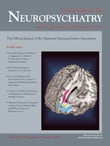SIR: A patient given lithium for bipolar disorder developed severe fatigue syndrome involving only the proximal limb muscles. The clinical and laboratory assessments revealed myasthenia gravis and thymic hyperplasia. Lithium was withdrawn and the patient underwent a thymectomy. A few months later the patient’s symptoms followed a more classical myasthenic symptomatology pattern involving ocular and pharyngeal muscles. This change of the clinical manifestations may suggest that lithium modified the onset and pattern of myasthenic symptomatology.
Treatment with lithium may produce muscle weakness as a transient side effect, early in the course of therapy. A severe neuromuscular junction disorder during lithium treatment has been reported in five cases.
1 –
4 Lithium caused a myasthenic syndrome in four of them, which remitted fully after lithium withdrawal.
1 –
4 One case of myasthenia gravis was unmasked by lithium and followed the typical course of the disease after lithium discontinuation.
4 We report here a similar case.
Case Report
A 33-year-old man suffering from bipolar disorder since the age of 23 was referred to our clinic because of resistant depression with suicidal thoughts. A negative personal and family history for neurological, autoimmune, and psychiatric disorders was reported. Lithium (900 mg/day, levels 0.72 meq/liter) was added to his treatment as he was receiving 40 mg/day citalopram. One month later, he complained of severe generalized weakness accompanied by several occasions of collapsing suddenly during activities. He stopped working, reduced his social activities, and remained most of the time at home. This reduction of social activity was not consistent with his improved mood. While standing during examination, he suddenly collapsed in a peculiar manner reminiscent of either a factitious or a conversion symptom. However, we elicited a positive fatigue test for the arms and the legs, and a 3-minute upward gaze fixation did not elicit diplopia. A full laboratory investigation followed, confirming the diagnosis of myasthenia gravis. Thyrotropin, free and total T4 and triidothyronine were in normal range. Antibodies against Acetylcholine-receptors (AchR) were high, at 45 nmol/liter. Lithium was discontinued. The patient was started on a regimen of valproic acid (1000 mg/day) for bipolar disorder and pyridostigmine for myasthenia gravis. A computed tomography (CT) scan of the mediastinum revealed thymic enlargement, and he subsequently underwent a thymectomy. Two years later he remained under treatment with prednisolone and pyridostigmine, having attained quite normal physical activity. Attempts to reduce corticosteroids led to relapses of myasthenic symptoms such as diplopia, difficulties in mastication, swallowing, and speech.
DISCUSSION
In our patient the high titer of serum AchR antibodies and the presence of lymphoid hyperplasia indicate that lithium was not the causative factor per se for the production of myasthenic symptoms. The mechanism of the lithium-induced elicitation of myasthenia gravis symptoms is unclear and mainly reflects a drug’s interaction with a concurrent or underlying neuromuscular disorder, rather than impending lithium toxicity. Neil et al.
1 postulated that lithium reduces acetylcholine synthesis. There is some evidence, based on electromyographic studies that long-term lithium administration can affect neuromuscular function in a manner that becomes symptomatically most apparent during acute deviations from neurophysiologic homeostasis.
1 Lithium may produce myasthenic symptoms because of its competition for calcium inside the presynaptic motor nerve terminal, finally reducing acetylcholine (Ach)-synthesis and voltage-gated quanta release of acetylcholine.
5 In myasthenia gravis the production of nicotinic-AchR-antibodies is regulated by nicotinic-AchR-specific T helper cells. Although T-cell activation was not specifically checked, lithium may enhance T-lymphocyte activity, resulting in the worsening of a myasthenia gravis-underlying autoimmune process.
3 Other studies suggest that there is a reduced number of acetylcholine receptors in denervated muscle preparations, raising the question that lithium may selectively increase the rate of breakdown of receptors without changing the rate of synthesis.
6In our case, the development of severe fatigue followed the onset of lithium treatment fairly rapidly. The initial involvement of the proximal muscles of the shoulders and hips suggested an unusual pattern of myasthenic symptoms. However, in our case, the symptoms were modified after lithium withdrawal, to a more “typical” myasthenic clinical presentation, such as weakness of extraocular, facial and pharyngeal muscles. All of these symptoms are thought to be part of the same illness because they have a) the characteristic fluctuations of myasthenic symptoms; b) the same electrophysiological picture (in repetitive stimulation test); c) an improvement following tensilon test and oral pyridostigmine; and d) the initial symptoms persisted, albeit in more subtle manner following lithium discontinuation.
Conclusions
We suggest that this is the second reported case of myasthenia gravis with thymic hyperplasia unmasked by lithium. Our case was characterized by an initial unusual clinical pattern involving the proximal limb muscles. As lithium is widely used for the treatment of affective disorders, we believe that clinicians should keep a close watch for unusual symptoms possibly related with neuromuscular junction dysfunction.

